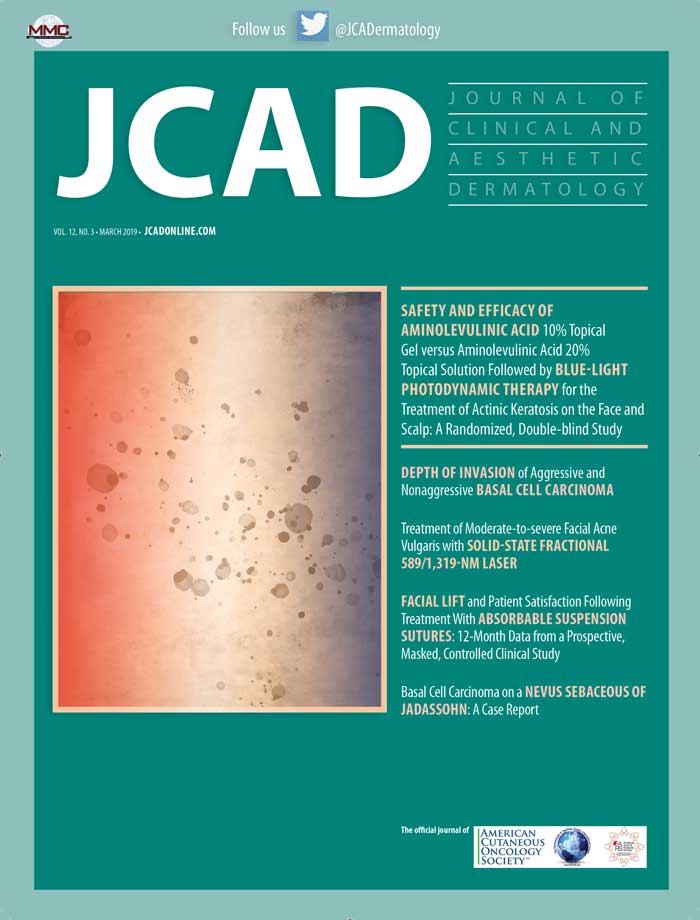 VOL. 12, NO. 3 • MARCH 2019
VOL. 12, NO. 3 • MARCH 2019
Dear Colleagues:
Welcome to the March 2019 issue of The Journal of Clinical and Aesthetic Dermatology (JCAD). Photodynamic therapy (PDT) using 10% 5-aminolevulinic acid (ALA) gel (GEL) for treating actinic keratosis (AK) has only been studied using red-light activation. In a study titled, “Safety and Efficacy of Aminolevulinic Acid 10% Topical Gel (GEL) versus Aminolevulinic Acid 20% Topical Solution (SOL) Followed by Blue-light Photodynamic Therapy for the Treatment of Actinic Keratosis (AK) on the Face and Scalp: A Randomized, Double-blind Study,” Nester et al evaluated safety and effectiveness of ALA GEL, compared to ALA SOL, using blue light exposure for treatment of AK. The investigators randomized 40 adults with AK to receive either GEL or SOL application to 4 to 8 AK lesions on the face or scalp followed by blue light exposure (1,000 seconds, 417nm, 10J/cm2). Primary outcomes included change in baseline AK lesions, and secondary outcomes included local skin reaction (LSR) scores and visual analog scale (VAS) pain scores. The authors reported that lesions treated with GEL were 97.1 percent cleared at Day 84 versus 94.9 percent for lesions treated with SOL; additionally, 86.8 percent of areas treated with GEL and 78.9 percent of areas treated with SOL showed 100-percent clearing. The authors concluded that the GEL was equivalent to SOL for clearing AK lesions on the face and scalp with blue-light PDT, but with less local skin reactions.
Next, in a study by Wetzel et al titled “Depth of Invasion of Aggressive and Nonaggressive Basal Cell Carcinoma,” the authors attempted to address the lack of current standard or recommended practice when it comes to reporting depth of invasion of basal cell carcinoma (BCC). In their study, the authors reviewed 500 original hematoxylin and eosin (H&E)-stained slides of biopsied BCCs, measuring the depth of invasion of each case. The authors also reviewed histologic features of each case to determine whether BCC was aggressive or nonaggressive. Descriptive statistics were calculated for all cases, comparing average depth of invasion with aggressive features versus cases with nonaggressive features. The authors observed that the difference between median depth of invasion between aggressive and nonaggressive cases was significant (p<0.0001), and this difference was maintained even with transection. The authors concluded that the median dermal invasion of histologically aggressive BCC is greater than nonaggressive tumors, and they hope their findings help clinicians when determining depth of biopsies and methods of treatment.
Following this, in a study titled, “Facial Lift and Patient Satisfaction Following Treatment with Absorbable Suspension Sutures: 12-Month Data from a Prospective, Masked, Controlled Clinical Study,” Nestor provides short- and long-term data on the duration of results and level of patient satisfaction following facial lifting procedures using absorbable suspension sutures in the midface. Twenty female subjects 41 to 75 years of age with moderate facial skin laxity were included in the study. A three-dimensional surface imaging system was used to measure facial lift, and patient and investigator satisfaction was assessed using the Global Aesthetic Improvement Scale and the FACE-Q questionnaire. The author observed statistically significant changes via the three-dimensional surface imaging system, and subject and investigator GAIS and FACE-Q scores indicated satisfaction with results. The author concluded that absorbable suspension sutures appear to offer a safe, minimally invasive approach to tissue lifting and repositioning, with long-term patient satisfaction.
Next, in a small, randomized, prospective, split-face, single-blinded study by Kang et al titled, “Treatment of Moderate-to-severe Facial Acne Vulgaris with Solid-state Fractional 589/1,319-nm Laser,” investigators evaluated the efficacy, safety, and patient satisfaction of a laser treatment for facial acne using a combination of wavelengths (589nm and 1,319nm). Nine patients were recruited to undergo four laser treatment sessions at 2- to 3-week intervals. On one side of the face, the patients received a pass using the 1,319nm laser alone, and on the other side of the face, patients received a pass with the 1,319nm laser followed by a pass with the 589nm laser. Effectiveness was assessed by a blinded, board-certified dermatologist who reviewed photographs and counted acne lesions on treated and nontreated sides. The authors reported that at the final visit, inflammatory acne lesions were reduced by 2.5 on the treatment side and increased by 1.1 on the control side, with no adverse reactions, and 77.8 percent of the patients reported overall satisfaction.
Finally, in a case report by Paninson et al titled, “Basal Cell Carcinoma on a Nevus Sebaceous of Jadassohn: A Case Report,” the authors describe a case of a 38-year-old man with a nevus sebaceous of Jadassohn present since birth that developed into basal cell carcinoma. Diagnostic methods, including histopathological findings, and treatment are described.
We hope you enjoy this issue of JCAD. As always, we welcome your feedback and submissions.
With regards,
James Q. Del Rosso, DO, FAOCD—Editor-in-Chief, Clinical Dermatology
Wm. Philip Werschler, MD, FAAD, FAACS—Editor-in-Chief, Aesthetic Dermatology
Seemal R. Desai, MD, FAAD— Associate Editor

